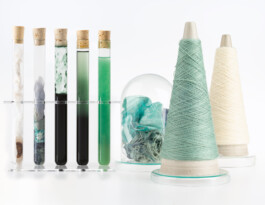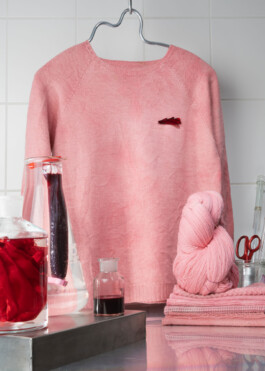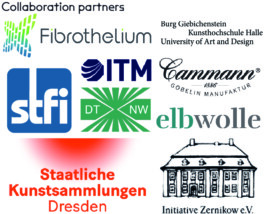Developing aesthetically recycling methods and products in the Anthropocene - this is the interdisciplinary starting point with which the project ReFiB - Recycling Fibroin is dedicated to the recycling of leftovers from silk production.
Worldwide, over 11 million tonnes of silk waste from production and used textiles are produced every year. As part of this research project various collaborations to local companies were established. Together we investigate how the fabric remnants can be recycled and used for textile design and beyond.
After the color sorting of silk production remnants, fibroins can be obtained by low-pollutant processes in solutions containing up to 20% fibroins. Organic forms such as sponges, films and granulates can be produced from this basic material. Only a small amount of the solution is sufficient for the refining process: One kilo of dissolved silk can be used to coat up to 100 kilos of wool.

The approach for design of future materials is to make scientific findings multisensual tangible.
From a design perspective, the focus is on which properties of the silk are retained in the recycling process: Can the optical sheen and the feel of the original silk be restored or transferred to other materials? Domestic wool in particular, whose quality is primarily scratchy, served here as a counterpart to silk. In various textile processes, the dissolved silk was applied to woolen yarn and fabric.
Following the acid dyeing of protein fibers, series of experiments were conducted on the binding of dissolved silk to wool fibers. The advantage here is that no additional crosslinkers are required for the wash-resistant binding of silk proteins to wool. The series of experiments show that, in addition to the fibroin, the dye of the silk was also bound to the wool fibre. At the same time, it could be validated that the material is perceived as softer and more skin-friendly after wool finishing with ReFib.
Pasty fibroin was applied to textile surfaces using textile printing processes. In various application and curing processes, the fibroin could be bonded to wool fabrics in patterns. This method also offers potential as a mono-material finish on silk.
Using design research methods, over hundreds samples have been created and documented. Under the research title silcularity, new strategies for a circular use of silks have thus emerged.

